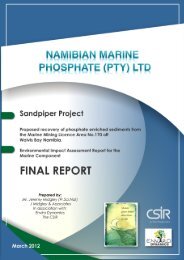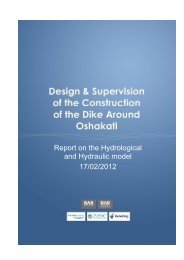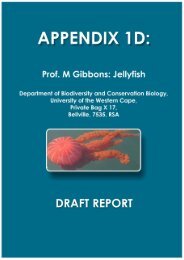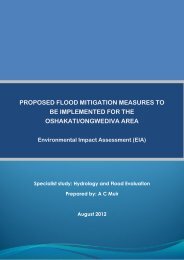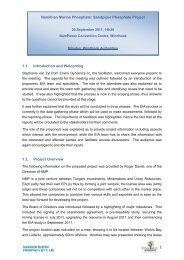Fisheries - Enviro Dynamics Namibia
Fisheries - Enviro Dynamics Namibia
Fisheries - Enviro Dynamics Namibia
Create successful ePaper yourself
Turn your PDF publications into a flip-book with our unique Google optimized e-Paper software.
F I S H E R I E S , M A M M A L S A N D S E A B I R D S S P E C I A L I S T S T U D Y<br />
As such direct impacts on non-target species are unlikely to occur. Rather it is the potential for<br />
the fishery to increase mortality on an<br />
already depleted target resource that is the<br />
main concern. Small pelagic species (sardine,<br />
horse mackerel, bearded gobies are an<br />
important link in marine food webs (Cury et<br />
al. 2000) and reductions in their abundance<br />
can have negative impacts on ecosystem<br />
structure and functioning (Crawford et al.<br />
1985, Crawford et al. 1987, Boyer and<br />
Hampton 2001b).<br />
3.5 DEMERSAL LONG-LINE FISHERY<br />
Final Report<br />
<strong>Namibia</strong>n Marine Phosphate (Pty) Ltd.<br />
Page 28<br />
Figure 14. Typical gear configuration of a pelagic<br />
purse seine vessel targeting small pelagic species<br />
Like the demersal trawl fishery the target<br />
species of this fishery is the Cape hakes, with a small non-targeted commercial by-catch that<br />
includes kingklip. The catch landed is predominantly prime quality (PQ) hake for export to Europe.<br />
The catch is packed unfrozen on ice – the fresh product is approximately 50% higher than that of<br />
trawled hake. Longline vessels fish in similar areas targeted by the hake-directed trawling fleet, in<br />
a broad area extending from the 300 m to 600 m contour along the full length of the <strong>Namibia</strong>n<br />
coastline. Approximately 18 boats are currently (2011) operating primarily in three broad areas.<br />
Vessels based in Lüderitz work south of 26°S towards the South Africa border while those based<br />
in Walvis Bay operate between 23°S and 26°S and north of 23°S. Operations are ad hoc and<br />
intermittent, subject to market demand. A total hake TAC of 131,780 tonnes was set for 2011 but<br />
less than 10,000 tonnes of this is caught by long-line vessels.<br />
A demersal long-line vessel may deploy either a double or single line which is weighted along its<br />
length to keep it close to the seafloor (Figure 15). Steel anchors, of 40 to 60 kg are placed at the<br />
ends of each line. These anchor positions are marked with an array of floats. Lines are typically 20<br />
– 30 nautical miles in length. Baited hooks are attached to the bottom line at regular intervals (1<br />
to 1.5 m) by means of a snood. Gear is usually set at night at a speed of 5 – 9 knots. Once<br />
deployed the line is left to soak for up to eight hours before it is retrieved. A line hauler is used to<br />
retrieve gear (at a speed of approximately 1 knot) and can take six to ten hours to complete.<br />
During hauling operations the vessel’s manoeuvrability is severely restricted.



